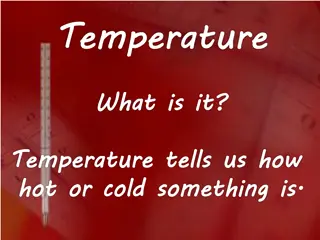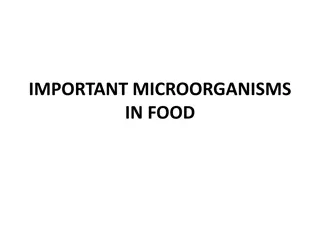Food Safety: Control Temperature to Prevent Bacteria Growth
Understand the importance of controlling food temperature to keep it safe from bacteria growth. Learn about the temperature danger zone, where bacteria thrive, and the proper handling procedures for buying, storing, cooking, holding, and reheating food. By following these guidelines, you can ensure food safety and prevent foodborne illnesses.
Download Presentation

Please find below an Image/Link to download the presentation.
The content on the website is provided AS IS for your information and personal use only. It may not be sold, licensed, or shared on other websites without obtaining consent from the author. Download presentation by click this link. If you encounter any issues during the download, it is possible that the publisher has removed the file from their server.
E N D
Presentation Transcript
Keep Food Safe: Control Food Temperature CACFP CACFP iTrain Simple Lesson Plan Simple Lesson Plan iTrain
Introduction Introduction Trainer and Participants Introductions
Temperature Danger Zone Temperature Danger Zone Within how many hours should food sitting at room temperature be cooled to prevent bacteria growth?
Overview Overview
Lesson Objective Lesson Objective Define the temperature danger zone.
Temperature Danger Zone Temperature Danger Zone The temperature danger zone is the temperature range of 40 F 140 F in which bacteria grow rapidly.
Flow of Food Flow of Food Buying Delivering Storing Preparing
Buying Groceries Buying Groceries Take coolers and ice packs Clean and organize refrigerators before receiving groceries Check refrigerator temperature (38 F) when putting food away freezers should be 0 F
Cooking Cooking Only take foods out of the refrigerator as needed when preparing for a meal Cook food to the appropriate internal temperature Always check and record the food temperature during and at the end of cooking
Holding and Serving Holding and Serving Keep hot food at 140 F or above Keep cold food at 40 F or less
Cooling and Reheating Cooling and Reheating Bacterial growth is the greatest when cooling foods due to the temperature drop Be sure to cool foods as quickly as possible Reheat leftover foods to 165 F within two hours Food should not be in the danger zone for more than 4 hours
Activity Activity Temperature Danger Zone: Keep Foods Out
Conclusion Conclusion
Lesson Conclusion Lesson Conclusion Keeping foods below 40 F or above 140 F slows the growth of bacteria. Throughout every step of handling food, keep food temperatures out of the temperature danger zone.
Activity Activity Speed Action Planning
Thank You! Thank You! The University of Mississippi The University of Mississippi School of Applied Sciences School of Applied Sciences www.theicn.org www.theicn.org 800 helpdesk@theicn.org helpdesk@theicn.org 800- -321 321- -3054 3054 Follow ICN on Social Media! Follow ICN on Social Media! Logo Pinterest Logo Logo Logo Facebook Twitter Instagram @ichildnutrition instagram.com/theicn pinterest.com/theicn facebook.com/ichildnutrition






















